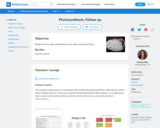
Objective
Students will be able understand the main idea of photosynthesis.
Big Idea
Food for plants!
- Subject:
- Biology
- Life Science
- Material Type:
- Activity/Lab
- Lesson Plan
- Author:
- Andrea Pless
- Date Added:
- 06/18/2021

Objective
Students will be able understand the main idea of photosynthesis.
Big Idea
Food for plants!
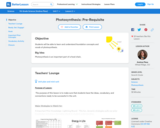
Objective
Students will be able to learn and understand foundation concepts and vocab of photosynthesis.
Big Idea
Photosynthesis is an important part of a food chain.
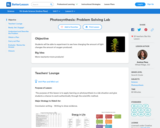
Objective
Students will be able to experiment to see how changing the amount of light changes the amount of oxygen produced.
Big Idea
More reactants=more products!
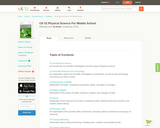
A complete introduction to scientific investigation and the scope of physical science. Includes: states of matter, atoms, periodic table, chemical bonding, chemical reactions, carbon chemistry, chemistry of solutions, nuclear chemistry, motion, forces, Newton's Laws of Motion, work and machines, energy, waves, sound, electromagnetic radiation, visible light, electricity, and magnetism.
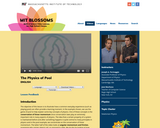
The objective of this lesson is to illustrate how a common everyday experience (such as playing pool) can often provide a learning moment. In the example chosen, we use the game of pool to help explain some key concepts of physics. One of these concepts is the conservation of linear momentum since conservation laws play an extremely important role in many aspects of physics. The idea that a certain property of a system is maintained before and after something happens is quite central to many principles in physics and in the pool example, we concentrate on the conservation of linear momentum. The latter half of the video looks at angular momentum and friction, examining why certain objects roll, as opposed to slide. We do this by looking at how striking a ball with a cue stick at different locations produces different effects.

The objective of this lesson is to illustrate how a common everyday experience (such as playing pool) can often provide a learning moment. In the example chosen, we use the game of pool to help explain some key concepts of physics. One of these concepts is the conservation of linear momentum since conservation laws play an extremely important role in many aspects of physics. The idea that a certain property of a system is maintained before and after something happens is quite central to many principles in physics and in the pool example, we concentrate on the conservation of linear momentum. The latter half of the video looks at angular momentum and friction, examining why certain objects roll, as opposed to slide. We do this by looking at how striking a ball with a cue stick at different locations produces different effects.
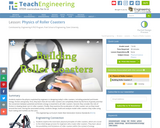
Students explore the physics utilized by engineers in designing today's roller coasters, including potential and kinetic energy, friction, and gravity. First, students learn that all true roller coasters are completely driven by the force of gravity and that the conversion between potential and kinetic energy is essential to all roller coasters. Second, they also consider the role of friction in slowing down cars in roller coasters. Finally, they examine the acceleration of roller coaster cars as they travel around the track. During the associated activity, the students design, build, and analyze a roller coaster for marbles out of foam tubing.

Earth contains a variety of plants to provide food, medicine and, most importantly, energy sources for humans. In this lesson, students will categorize plants by their components and shapes. Additionally, they will learn the mechanisms behind the making of medicines and bio-fuels. It is important that the students have prior knowledge of the plant cell structures and functions. The video duration is 21 minutes, during which the students will use skills such as classification and experimentation. The students must therefore be supplied with various samples of plants. In Arabic with English subtitles.

Earth contains a variety of plants to provide food, medicine and, most importantly, energy sources for humans. In this lesson, students will categorize plants by their components and shapes. Additionally, they will learn the mechanisms behind the making of medicines and bio-fuels. It is important that the students have prior knowledge of the plant cell structures and functions. The video duration is 21 minutes, during which the students will use skills such as classification and experimentation. The students must therefore be supplied with various samples of plants. In Arabic with English subtitles.

Acting as civil engineers hired by the U.S. Department of Transportation to research how to best use piezoelectric materials to detect road damage, student groups are challenged to independently create their own experiment procedures, working with given materials and tools. The general approach is that they set up model roads using rubber mats to simulate asphalt and piezoelectric transducers to simulate the in-ground road sensors. They drop heavy bolts at various locations on the “road,” collecting data and then analyzing the voltage changes across the piezoelectric transducers caused by the vibrations of the bolt hitting the rubber. After making notches in the rubber “road” to simulate cracks and potholes, they collect more data to see if the piezo elements detect the damage. Students write up their research and conclusions as if presenting evidence to USDOT officials about how the voltage changes across the piezo elements can be used to indicate road damage and extrapolated to determine when roads need maintenance service.
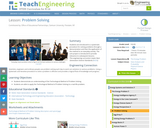
Students are introduced to a systematic procedure for solving problems through a demonstration and then the application of the method to an everyday activity. The unit project is introduced to provide relevance to subsequent lessons.

Students will learn how to use Flipgrid to record videos. Students will watch Crash Course Kids videos related to the transfer of matter and energy within an ecosystem and use that information (as well as information from outside sources, if desired) to create a puppet show. They will use Flipgrid to record their puppet shows and be able to watch each other’s shows.
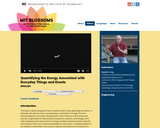
The topic of this video is energy in general, and specifically the ways we can quantify it. In order to make the concepts accessible to a broad audience, this video focuses on everyday things and events. How is it that energy plays a part in a child riding a scooter? How is the energy we consume in playing related to the energy on the food we eat? This video poses these questions to the class and challenges them to put a list of five such items into an ordering from most energy to least.

The topic of this video is energy in general, and specifically the ways we can quantify it. In order to make the concepts accessible to a broad audience, this video focuses on everyday things and events. How is it that energy plays a part in a child riding a scooter? How is the energy we consume in playing related to the energy on the food we eat? This video poses these questions to the class and challenges them to put a list of five such items into an ordering from most energy to least.

This article from Beyond Weather and the Water Cycle provides ideas on how school librarians can work with elementary teachers to teach about the Sun's impact on weather and climate. The author introduces the Standards for the 21st Century Learner, developed by the American Association of School Librarians. The author focuses on Standard 1, which calls for students to inquire, think critically, and gain knowledge through developing and refining questions, investigating answers, seeking divergent perspectives in information, and assessing whether the information found answers the questions posed. The free, online magazine draws its themes from the Seven Essential Principles of Climate Literacy, with each issue focusing on one of the seven principles.
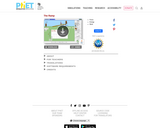
Explore forces, energy and work as you push household objects up and down a ramp. Lower and raise the ramp to see how the angle of inclination affects the parallel forces acting on the file cabinet. Graphs show forces, energy and work.
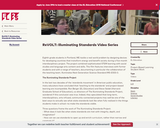
Eighth grade students in Portland, ME tackle a real world problem by designing devices for developing countries that transform energy and benefit society during a five-month interdisciplinary project. The project combined sophisticated STEM learning with social studies and language arts content and skills. This film features interviews with former students and with a range of teachers, documenting in particular the collaboration of the teaching team.
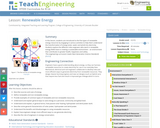
In this lesson, students are introduced to the types of renewable energy resources. They are involved in activities to help them understand the transformation of energy (solar, water and wind) into electricity. Students explore the different roles of engineers working in renewable energy fields.
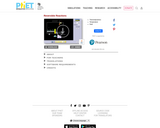
Watch a reaction proceed over time. How does total energy affect a reaction rate? Vary temperature, barrier height, and potential energies. Record concentrations and time in order to extract rate coefficients. Do temperature dependent studies to extract Arrhenius parameters. This simulation is best used with teacher guidance because it presents an analogy of chemical reactions.
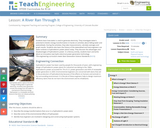
Students learn how water is used to generate electricity. They investigate water's potential-to-kinetic energy transformation in hands-on activities about falling water and waterwheels. During the activities, they take measurements, calculate averages and graph results. Students also learn the history of the waterwheel and how engineers use water turbines in hydroelectric power plants today. They discover the advantages and disadvantages of hydroelectric power. In a literacy activity, students learn and write about an innovative new hydro-electrical power generation technology.